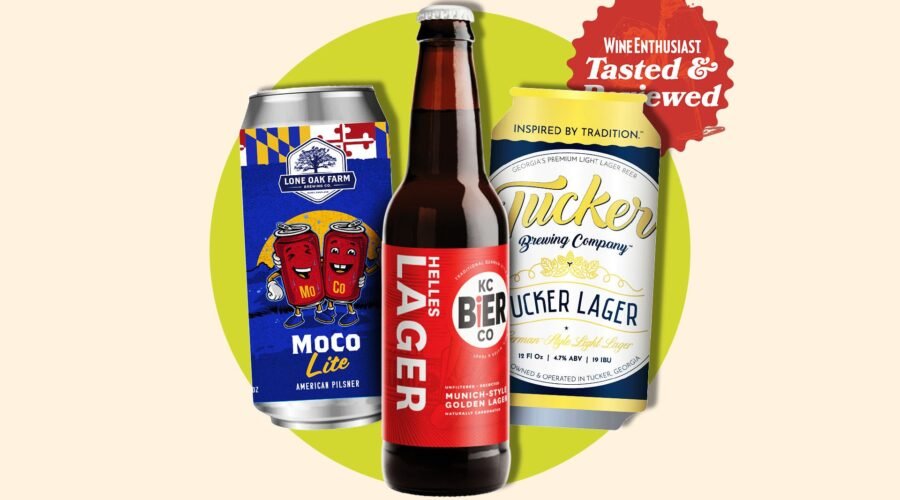Ratings: The Best Light Beer to Drink Right Now
The idea of light beer has been around in the United States since the 1960s, when Rheingold Brewery released Gablinger’s Diet Beer. It was not a commercial success. However, it laid the groundwork for what would become the largest and best-selling category in beer: the American light lager.
Despite its widespread popularity, there have been endless jokes by critics, comics and global citizens that hail from long-established beer countries against light lager. But the fact is, light beer—especially lagers—appeal to a large swath of drinkers because of its fewer calories and low alcohol-by-volume (abv).
“Light lager is an occasion beer,” says Karlton Graham, head brewer of Kansas City Bier Co. in Missouri. “It’s the beer that you choose when you are going to smoke a brisket all day or go tailgating for six hours. It’s the beer you have when you’re going to have more than three.”
Here’s everything to know about this often (unfairly) maligned category of brews, plus which light beers to buy.
What Is Light Beer?
Light beer is a lighter version of a full-strength beer. This often means fewer calories, carbohydrates and, possibly, a more delicate flavor. Light beers have evolved from the 1960s to today, but the focus has always been on refreshment with a nod to the “better-for-you” mindset.
A Brief History of Light Lagers in the U.S.A.
The United States had a robust brewing industry going into the 1920s, with several thousand breweries operating across the country, often concentrated in the major cities. During this time, many different styles of beer were being produced, often influenced by the traditions and techniques brought to U.S. shores by immigrants.
But Prohibition, which lasted from 1920 to 1933, decimated the industry. However, the breweries that survived—including Pabst, Anheuser-Busch, Miller, Coors, Yuengling and a handful of others—would go on to thrive and put their focus on lagers. Over the next few decades, advancements in refrigeration and transportation made it easier to get the lagers into consumer hands. Soon, the American light lager was as ubiquitous as Wonder Bread, with a lot of the same bland, made-for-all traits.
Then, in mid-1970s, Miller Lite was released. At the time, Miller Brewing Company was looking to create a beer that could appeal to a broader market and the health-conscious. Miller Lite was based on the recipe for Meister Brau Lite, a repackaged version of Rheingold’s original diet beer, which flopped. A marketing firm did the heavy lifting for Miller Lite, removing references to diets and focused on flavor and taste, and had celebrities and notable personalities promote the brand on television and radio commercials.
Soon after, both Budweiser and Coors released light lagers, officially ushering in a new era in beer.
But it’s not just industry titans that got into the light lager game. Today, we see craft brewers also in the category. This is in stark contrast to the early microbrews of the 1970s, which were arguably designed in repudiation of the American light lager. These brewers desired to brew beer with robust flavor, loaded with hops, dark and specialty malts and yeast strains of distinction.
“Craft beer as a whole has been going towards these really palate-heavy hazy IPAs, milkshake IPAs and all of that stuff, and as an industry we went hot and heavy into it,” says Rich Eyring, senior brewer for Mass Bay Brewing Company, which includes Harpoon, UFO, Clown Shoes, City Roots Cider and Arctic Chill Hard Seltzer brands.
“I think everybody is now coming out with crisp [beers] as a little bit of a course correction, to try to get that easier drinkability back on the market,” Eyring says. “I think everyone is excited about it.”
In keeping with the demand, Harpoon recently released American Flyer Light, a light lager designed to fill that niche. Proceeds from each case go to support military families.
Light Beer Beyond the Lager
Lagers have typically received the light-beer treatment. But now one can find stouts, fruit beers and IPAs billed as low-calorie, low carb and with a “healthier for you” bent.
For craft brewers that have gone big on flavor with their other brews, threading the needle of light beers can be a challenge.
“We underestimated the degree to which a lot of people like their light beer to taste like almost nothing,” says Graham when recalling the launch of the brewery’s KC Light, a pilsner that still has more malt and hop derived flavor than more established commercial light beers.
As the brewery has dialed in the recipe, it has gained a loyal local following, showing that light beers can be a small batch delight.
The Best Light Beers to Drink Right Now
FAQs
Is Light Beer Made Differently Than Regular Beer?
Light beer was developed by biochemist Joseph Owades. He created a way to isolate enzymes that would consume higher calorie starches, making it easier for brewing yeast to consume and ferment.
How Many Calories Are in Light Beer?
It varies by brand, but most aim to be around 100 calories or fewer per bottle.
Why You Should Trust Us
All products featured here are independently selected by our team, which is comprised of experienced writers and wine tasters and overseen by editorial professionals at Wine Enthusiast headquarters. All ratings and reviews are performed blind in a controlled setting and reflect the parameters of our 100-point scale. Wine Enthusiast does not accept payment to conduct any product review, though we may earn a commission on purchases made through links on this site. Prices were accurate at the time of publication.


